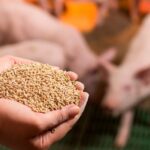Fumaric acid stockfeed grade is a kind of food acid made for animal feed. Farmers use it to make the feed less acidic and help it stay fresh longer. This ingredient helps make feed better and supports good animal nutrition. Producers pick fumaric acid stockfeed grade because it works in many diets and is very safe.
Uses of Fumaric Acid in Animal Nutrition

Fumaric Acid in Feed
Farmers and feed makers put fumaric acid stockfeed grade in animal feed for many reasons. This ingredient helps keep the feed at the right acidity. It helps animals have healthy stomachs. Fumaric acid also helps feed last longer and stay fresh. It mixes easily and does not change how the feed feels.
Pigs, poultry, ruminants, and dogs all get benefits from fumaric acid in their food. In poultry, it helps keep their gut healthy. Feed makers usually add between 0.5% and 1% fumaric acid to the feed. These amounts are safe for all animals.
Tip: Always use the right amount of fumaric acid. This keeps animals healthy and makes feed better.
Digestion & Absorption
Fumaric acid helps animals digest their food. When animals eat feed with fumaric acid, their stomachs stay more acidic. This helps good bacteria grow. It also helps animals take in more nutrients. Animals use their food better and grow faster.
Ruminants like cows and sheep break down fumaric acid quickly. The European Food Safety Authority says fumaric acid is safe for ruminants, even at higher amounts than for pigs and poultry. Fumaric acid does not build up in animal bodies. It is safe for people who eat products from these animals. Fumaric acid helps animals get more nutrition from their food.
Palatability & Preservation
Animals need to like their feed to eat well and grow. Fumaric acid makes feed taste better for them. When animals like their food, they eat more and grow stronger. Fumaric acid also keeps feed from going bad. It stops mold and bacteria from growing. This keeps feed safe and fresh for longer.
Feed stays good longer with fumaric acid. Farmers see less spoiled feed and less waste. Dogs, pigs, poultry, and ruminants all eat better when their feed has fumaric acid. This ingredient helps keep feed safe and healthy by stopping bad germs.
| Animal Species | Typical Inclusion Level | Main Benefits |
|---|---|---|
| Pigs | 0.5% – 1% | Better digestion and growth |
| Poultry | 0.5% – 1% | Healthy gut and absorption |
| Ruminants | 0.5% – 1%+ | Safe and efficient metabolism |
| Dogs | 0.5% – 1% | Tasty feed and good digestion |
Note: Fumaric acid can hurt your eyes and lungs. People who handle it should be careful and wear safety gear.
Benefits and Drawbacks of Fumaric Acid in Animal Nutrition
Impact of Fumaric Acid on Feed Efficiency and Animal Growth Performance
Fumaric acid helps animals use their food better. Farmers see animals grow faster with this ingredient. Pigs and poultry often get bigger with less feed. Animals need less food to gain weight. Fumaric acid keeps feed fresh for longer. This helps animals eat more and waste less food. Some studies show cows and sheep make less methane with fumaric acid. This can help farms be kinder to the environment.
Animals eating fumaric acid feed have healthier stomachs and better digestion.
Here is a table with some main benefits:
| Benefit | Animal Species |
|---|---|
| Improved weight gain | Pigs, Poultry |
| Better feed efficiency | Pigs, Poultry |
| Lower methane emissions | Cows, Sheep |
| Longer feed shelf life | All species |
Potential Limitations and Considerations When Using Fumaric Acid in Animal Nutrition
Farmers must use the right amount of fumaric acid. Too much can make feed taste sour. It can upset animals’ stomachs. Some animals may not like the taste if it is too strong. People who work with fumaric acid should wear gloves and masks. The powder can bother skin and lungs. Feed makers need to follow safety rules. They should check each batch for quality.
Tip: Always follow expert advice and label instructions when using fumaric acid in animal feed.
Some animals, like young piglets, may need less at first. Each farm should test and watch how animals do. Careful use keeps animals healthy and feed safe.
Fumaric Acid Safety and Comparison with Other Additives

Comprehensive Safety Guidelines and Best Practices for Using Fumaric Acid in Animal Feed
Fumaric acid stockfeed grade is very safe for animal feed. Experts from EFSA and FDA have checked it. They made rules to keep animals healthy. Science shows fumaric acid is safe for animals, people, and nature if used right. But it can hurt skin, eyes, and lungs. Workers should wear gloves, masks, and goggles when using the powder.
The table below lists key safety facts:
| Aspect | Details |
|---|---|
| Safe use level for pigs and poultry | Up to 20,000 mg/kg in complete diets |
| Margin of safety for pigs and poultry | About 2 |
| Safe use level for ruminants | Higher than pigs and poultry; no set limit needed |
| Safe use level for milk replacer (veal calves and young mammals) | Max 10,000 mg/kg; no safety margin |
| Metabolism and residue | Breaks down fast; does not build up in animals; people are not at risk |
| Irritation potential | Can hurt eyes badly; dust may bother lungs; breathing it should be avoided |
| Environmental risk | No danger for the environment |
| FDA evaluation | Fumaric acid esters can be risky for people, but this does not apply to fumaric acid stockfeed grade |
Feed makers must measure the right amount each time. They should keep fumaric acid dry and away from kids and pets. The EFSA FEEDAP Panel found no new safety problems for land animals. They could not say it is safe for water animals in every case.
Tip: Always read the label and wear safety gear when using fumaric acid.
Comparison of Fumaric Acid with Other Common Organic Acids Used in Animal Feed
Fumaric acid works well in animal feed. Other acids also help animals grow and stay healthy. Each acid has its own good points and safety rules.
- Fumaric acid is safe for pigs and poultry at the right amount. It does not stay in animal bodies and has a good safety margin. The powder can bother eyes and lungs.
- Lactic acid makes stomachs more acidic and fights bad bacteria like E. coli. It helps piglets have healthy stomachs and less sickness.
- Formic acid and its salts help animals eat more, gain weight, and digest food better. They also help gut health.
- Fumaric acid at high levels can change gut bacteria in piglets and lower some germs.
- All these acids are safe if used right. Fumaric acid needs careful handling, while others help gut health in different ways.
Farmers pick the acid that fits their animals and safety needs. Fumaric acid gives strong benefits, but workers must be careful when using it.
Fumaric acid stockfeed grade makes animal feed better and safer. It helps animals get more nutrition from their food. Farmers use it to help pigs, poultry, ruminants, and dogs grow strong. It also helps animals digest their food well. Groups that make rules say it is safe for most animals. It does not hurt the environment. The table below gives important advice:
| Aspect | Recommendation / Finding |
|---|---|
| Safety for pigs/poultry | Safe up to 20,000 mg/kg in feed |
| Safety for ruminants | Higher levels tolerated; no set maximum |
| User safety | Can irritate eyes, skin, and lungs; handle with care |
| Environmental impact | No risk to the environment |
Farmers need to follow the rules to use this additive the right way.
FAQ
What is fumaric acid stockfeed grade used for in animal feed?
Fumaric acid additive helps feed stay fresh and safe. It makes digestion better and feed taste nicer. Farmers use it so animals grow well and stay healthy.
Is fumaric acid safe for all animals?
Yes, experts say fumaric acid is safe for pigs, poultry, ruminants, and dogs if used right. Farmers must follow the label and safety rules every time.
How does fumaric acid improve animal growth?
Fumaric acid keeps the stomach more acidic. This helps animals break down food and get more nutrients. Animals often grow faster and use feed better.
Can fumaric acid replace other feed acids?
Fumaric acid can be used with or instead of other acids like lactic or formic acid. Farmers pick the acid that fits their animals and feed plans.
What safety steps should workers take when handling fumaric acid?
Workers need gloves, masks, and goggles. Fumaric acid powder can bother eyes, skin, and lungs. Always keep it dry and away from kids and pets.




